As a collector of the real vintage Japanese tiles as well as happy owner of modern interpretations on these traditional designs, I also wanted to offer a buyer's guide: should you collect the real antiques, or modern versions? What sort of prices should you expect to pay? Are there any ethical issues in buying old tiles? (Spoiler: there don't seem to be, but always trust your gut). And, of course, where can one find them?
The pictures will be a bit scattered and cover several countries -- they are here for your aesthetic enjoyment and don't necessarily follow the flow of the text.
Part of my own collection of Taiwanese Majolica
The style we now call Majolica was probably invented in the Middle East or Iran centuries ago. It arrived via trade routes to Europe by the 1400s, where it became especially popular in Italy, and became known as "Faenza tiles", for the Italian city known for producing them. The original method from the Middle Ages and Renaissance involved lead-glazed ceramics colored with tin oxides.
Original colors were therefore all based on tin oxides: manganese purple, antimony yellow, cobalt blue, copper green and rust orange. In fact, this is likely why the Majolica tiles one sees in places like southern Spain so often follow a blue/yellow/green/orange color scheme: if they're old enough, those were the only possible colors.
The firing process and generally viscous paints allowed multicolored tiles to be fired only once, making brightly-colored wares more affordable and accessible. By the Victorian Era, this is part of what fueled their popularity -- as attractive, colorful signifiers of middle-class status.
Bookmark this for later: the same Middle Eastern origins of these tiles also spread eastward to India, and for years along those trade routes, they were associated with Islamic art and architecture (for example, in Mughal India). That would change in the 19th century, however -- and this link is a fascinating read.
The style made its way to Spain, where they came to be known as "Majolica", a corruption of Majorca, the place where such wares entered the country. They were called faience (after the city of Faenza) in France and 'delft' in the Netherlands. The blue-and-white style became especially popular beyond Spain, including Portugal.
Not all "Majolica" tiles are of the same type: some were etched and filled with paint to create something of a shiny, brightly-colored almost three-dimensional effect. Blue colors especially did a fantastic job of mimicking water. Some were simply painted on the shiny white finish of plain tiles. Some looked more like pools of limpid color, others were more opaque with visible brushstrokes and overlapping colors. Some took on a distinctly European style, some imitated Chinoiserie in blue and white, and some -- especially in Spain -- retained their Middle Eastern aesthetic roots. Some were transfer-printed geometric designs that didn't look like painted glass at all.
It's hard to say of any or all of these could truly be called "Majolica", but when I use the term I'm specifically referring to the glazed tiles -- some in three- dimensional relief and some not -- popular in Taiwan in the early 20th century.
Original colors were therefore all based on tin oxides: manganese purple, antimony yellow, cobalt blue, copper green and rust orange. In fact, this is likely why the Majolica tiles one sees in places like southern Spain so often follow a blue/yellow/green/orange color scheme: if they're old enough, those were the only possible colors.
The firing process and generally viscous paints allowed multicolored tiles to be fired only once, making brightly-colored wares more affordable and accessible. By the Victorian Era, this is part of what fueled their popularity -- as attractive, colorful signifiers of middle-class status.
Bookmark this for later: the same Middle Eastern origins of these tiles also spread eastward to India, and for years along those trade routes, they were associated with Islamic art and architecture (for example, in Mughal India). That would change in the 19th century, however -- and this link is a fascinating read.
The style made its way to Spain, where they came to be known as "Majolica", a corruption of Majorca, the place where such wares entered the country. They were called faience (after the city of Faenza) in France and 'delft' in the Netherlands. The blue-and-white style became especially popular beyond Spain, including Portugal.
Not all "Majolica" tiles are of the same type: some were etched and filled with paint to create something of a shiny, brightly-colored almost three-dimensional effect. Blue colors especially did a fantastic job of mimicking water. Some were simply painted on the shiny white finish of plain tiles. Some looked more like pools of limpid color, others were more opaque with visible brushstrokes and overlapping colors. Some took on a distinctly European style, some imitated Chinoiserie in blue and white, and some -- especially in Spain -- retained their Middle Eastern aesthetic roots. Some were transfer-printed geometric designs that didn't look like painted glass at all.
It's hard to say of any or all of these could truly be called "Majolica", but when I use the term I'm specifically referring to the glazed tiles -- some in three- dimensional relief and some not -- popular in Taiwan in the early 20th century.
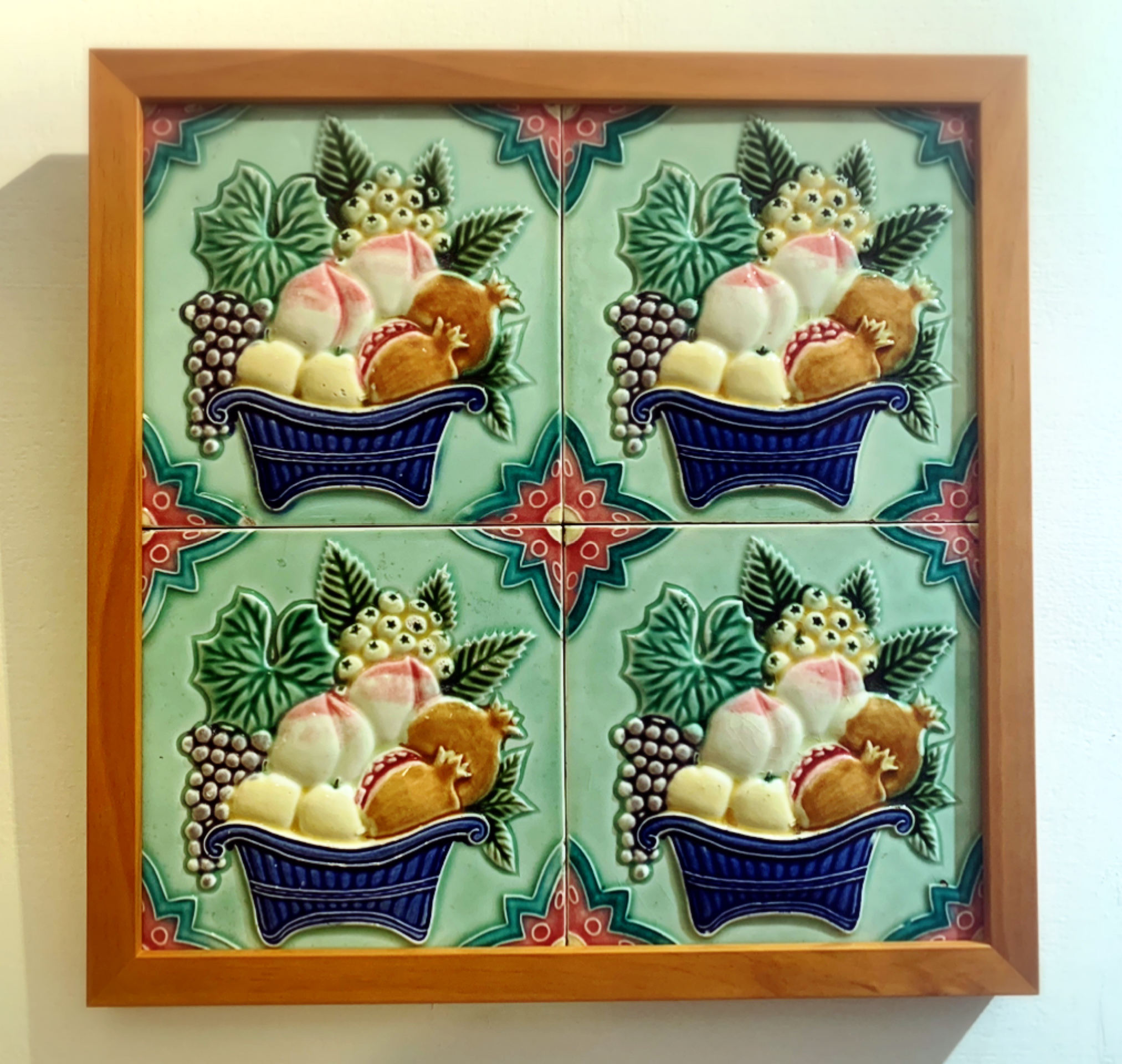
The baskets of fruit, including grapes, peaches and pomegranates, proved popular with Asian buyers
The style fell out of fashion for awhile, but was resurrected in Europe in later centuries, and enjoyed a huge boom in popularity in Victorian times.
Victorian times were also colonial times, so perhaps it's clear where this is going.
The Great Exhibition of 1851 (something like a World's Fair) in London brought the style back in a big way. Across Europe -- but especially in England -- the tiles began to be used to decorate houses and public areas. They were especially common on the walls of pubs and around fireplaces, being easy to clean and able to withstand high temperatures. They began to be mass produced by companies like Minton and Wedgewood, which used fanciful designs that called back to nature (a 'return to nature' was a big thing, stylistically). Industrialization and improved techniques made these colorful items available to the masses. They were seen as sanitary (easy to clean) and attractive -- again, a sign of middle-class status in the 19th century.
Victorian times were also colonial times, so perhaps it's clear where this is going.
The Great Exhibition of 1851 (something like a World's Fair) in London brought the style back in a big way. Across Europe -- but especially in England -- the tiles began to be used to decorate houses and public areas. They were especially common on the walls of pubs and around fireplaces, being easy to clean and able to withstand high temperatures. They began to be mass produced by companies like Minton and Wedgewood, which used fanciful designs that called back to nature (a 'return to nature' was a big thing, stylistically). Industrialization and improved techniques made these colorful items available to the masses. They were seen as sanitary (easy to clean) and attractive -- again, a sign of middle-class status in the 19th century.
Not all Majolica items are tiles: in fact, the style more typically referred to housewares made of inexpensive earthenware or clay, fired with a tin glaze providing a white, glossy surface for painting. In the Victorian era, Majolica pots, urns, pitchers and servingware were all popular. I don't have time to talk about those, and that style isn't particularly to my liking (lots of pitchers decorated with bulbous grapes or squirrels) -- let's focus on the tiles.
Reproduction (modern) tiles using traditional designs, available at the Museum of Old Taiwan Tiles with shops in Tainan, Taipei and the museum in Chiayi
Taiwanese Majolica tiles turned into decorative hangings using vintage glass and window framing, purchased here
These tiles fell out of fashion towards the end of the 19th century, as their bright colors and naturalistic elements -- plants, animals, leaves, feathers, fruit -- didn't quite mesh with the incoming Art Nouveau and Bauhaus styles.
However, they didn't disappear entirely: if you look at vintage tiles from that era, the whimsical floweriness of Art Nouveau started to show up in tile designs, replacing prim Victorian roses. Look hard enough and you'll even find some tiles with Art Deco influences, including some with a Streamline style.
However, they didn't disappear entirely: if you look at vintage tiles from that era, the whimsical floweriness of Art Nouveau started to show up in tile designs, replacing prim Victorian roses. Look hard enough and you'll even find some tiles with Art Deco influences, including some with a Streamline style.
This was also around the time that they began to catch on in Asia.

A few things happened here: in India, upper-class Indians often sought to imitate the British colonizers, including decorating their own homes with the tiles they saw in British houses.
At the same time, the British wanted to promote "sanitation" -- as they saw it, cleaning up India by tiling as many surfaces as possible. A house with a tile floor was a "clean" house, it seems. Once associated with Mughal design, these tiles became associated with modernity (and, yes, colonialism).
But what did South and Southeast Asians want in their tiles, and could Europe provide it?
The answers seemed to be bright colors, fancier (more expensive) designs for the upper classes, and no -- England could not provide enough of them affordably.
Four of my favorites: an early Art Deco style (note the Streamline influence and minty color), an Art Nouveau (the natural floral lines, ornate but not feminine, lots of rust and purple), a rare green and purple combination with an octagon, and a lion with a deep, limpid blue background setting off green leaves -- explicitly for the Chinese/Taiwanese market)
At the same time, after Japan was forced at gunpoint to end its isolation with the rest of the world, they began a rapid process of industrialization. Foreigners were moving in, and decorating their houses in Japan with these colorful painted tiles.
Some Japanese saw a business opportunity, and began experimenting with tile manufacturing. By the early 1900s, they were more or less able to replicate the imported European tiles, and started their own manufacturing enterprises.
This was also the period of early colonial rule in Taiwan, as well as a great deal of trade between different communities across Asia.
If the Chettiars of Tamil Nadu (a well-known group who traded extensively and made massive fortunes) had gorgeous peacock and floral tiles, their counterparts in Southeast Asia wanted them too. Many of those communities were ethnically Chinese, and some had roots in Kinmen.
Desire for these brightly-colored tiles among wealthy Asian communities began to grow -- perhaps inspired by what they saw imported from Europe, but far more local as time went on. The yanglou 洋樓 of the Kinmen elites were often practically encrusted with these tiles, just as the mansions of the Chettiars in Tamil Nadu. (Chettinad itself is still a center of tile manufacturing, though the method is quite different from the tiles in these pictures).
Some Japanese saw a business opportunity, and began experimenting with tile manufacturing. By the early 1900s, they were more or less able to replicate the imported European tiles, and started their own manufacturing enterprises.
This was also the period of early colonial rule in Taiwan, as well as a great deal of trade between different communities across Asia.
If the Chettiars of Tamil Nadu (a well-known group who traded extensively and made massive fortunes) had gorgeous peacock and floral tiles, their counterparts in Southeast Asia wanted them too. Many of those communities were ethnically Chinese, and some had roots in Kinmen.
Desire for these brightly-colored tiles among wealthy Asian communities began to grow -- perhaps inspired by what they saw imported from Europe, but far more local as time went on. The yanglou 洋樓 of the Kinmen elites were often practically encrusted with these tiles, just as the mansions of the Chettiars in Tamil Nadu. (Chettinad itself is still a center of tile manufacturing, though the method is quite different from the tiles in these pictures).
Some modern takes on old tile patterns -- silicone coasters from the Museum of Taiwan Tiles, and a peacock coaster from Perfume Tiles (which also sells solid perfume).
Sensing this demand, the Japanese companies making the tiles began to create designs that would appeal to South Asians and Chinese. Colors got brighter -- the pale lavenders and pinks of the English tiles became bright greens and bubblegum colors. Images these communities like began to be produced: peacocks, lions, fruit and flowers that symbolized prosperity, community or longevity -- fewer English roses and more bamboo, Buddha's Hand, birds, lions, peaches and pomegranates. Baskets overflowing with fruit.
Lotus flowers and lilies also became popular, and with the rise of Indian nationalism, there was a massive demand for Hindu iconography in India. Tiles bearing Krishna, Lakshmi, Sarasvati and more began to appear, often directly imitating the influential work of painter Raja Rami Varma. Demand only grew between the two world wars, at a time when Japan could provide but Europe, perhaps, could not.
Lotus flowers and lilies also became popular, and with the rise of Indian nationalism, there was a massive demand for Hindu iconography in India. Tiles bearing Krishna, Lakshmi, Sarasvati and more began to appear, often directly imitating the influential work of painter Raja Rami Varma. Demand only grew between the two world wars, at a time when Japan could provide but Europe, perhaps, could not.
Modern reproduction tile coasters from the Museum of Taiwan Tiles
In India, the rise of the swadeshi movement caused Indians avoid British-made goods. Japanese ones, however, were considered an acceptable substitute by some. They might not be Indian, but at least they weren't British! Southeast Asia was probably less ideologically driven to buy the Japanese tiles as simply finding them more affordable and aesthetically pleasing.
In Taiwan, conidering the contact that wealthy Taiwanese would have had with the Japanese and other Asian communities as well as the West, it isn't surprising that demand for these tiles grew, giving Japan another market.

Peacock Majolica from a Chettinad mansion
You can see them in situ in many of the pictures below, as well as here at the Kuo Family Mansion. Xianse Temple in Sanchong also has some lovely ones, and they are easy to find on preserved mansions in Kinmen. In Taichung, the old Wu residence gatehouse, relocated to Taichung Park, is decorated with Majolica.
In other words, as demand for Majolica fell in Europe, it spiked in Asia, with India as a leading market, though many found their way to Taiwan -- a prosperous territory, even as a colony.
If the Japanese Majolica looks brighter than its Western counterparts, or incorporates more post-Victorian design trends (such as Art Nouveau and Art Deco) and even seems highly market-specific, that's because it is.
It wasn't going to last, of course: World War II kicked up, there was no budget or supply chain for luxuries, and Japanese Majolica tile production dropped off.
Whatever was already in Taiwan was more or less Taiwan's Majolica legacy. That is to say, the real stuff is almost entirely post-1900, but pre-war. Old, but not ancient.
Some pieces, however, are rare enough to sell for huge sums. I didn't pay this much, but I've seen lion designs like this one go for NT$12,000 per tile.
Whatever was already in Taiwan was more or less Taiwan's Majolica legacy. That is to say, the real stuff is almost entirely post-1900, but pre-war. Old, but not ancient.
Some pieces, however, are rare enough to sell for huge sums. I didn't pay this much, but I've seen lion designs like this one go for NT$12,000 per tile.
So, what to do if you want a few of these tiles for yourself, or simply a decorative item that evokes this history?
The tiles are no longer made, but the Museum of Old Taiwan Tiles has led the way -- and created an excellent example -- for salvaging these pieces of 'everyday' art from old houses that are slated for demolition. The museum acquires the tiles, cleans and refurbishes them, and either displays them in their small museum space in Chiayi or returns them to any original owners who want them back.
From them, you can buy modern designs based on these traditional tiles at affordable prices. Larger ones can be used as trivets, and smaller ones as coasters (there are also tea tray, mirror and coat hook options). The museum shop -- located in Red House in Taipei, Blueprint Cultural and Creative Park in Tainan and the museum itself in Chiayi -- also sells a variety of related items, including jewelry, compact mirrors, tiled bathroom mirrors, washi tape and more.
Yes, you can tell the difference between the new and old versions -- look above, and you'll note the opaque colors and uniform flat designs. However, they make excellent coasters, tiles for decorative projects and trivets. I've never sensed disappointment when giving one as a gift.
The museum occasionally offers limited runs of hand-painted tiles in the same style and colors as the originals. I bought this peacock from them -- it looks authentic, but it's quite new. These will cost more, however (between $1800 and $4000NT depending on whether you buy a design with a single tile or two).
Perfume Tiles are another option. They pop up in Eslite, and many of the "cultural and creative" markets around Taiwan, as well as on Pinkoi.
But let's say you want originals. You should use these as decorative items only; the Museum of Taiwan Tiles reproductions make good coasters and trivets, but the true antiques won't. You can even see in my set of four coasters that I had to give it a bit of a gold paint job after my cat knocked it off the table!
A tiled mansion -- check out the ceiling! -- in Chettinad, India
Real antiques will, of course, cost more. A common design such as the ones below might run anywhere from NT$700 to NT$1300, depending on the seller and the condition of the tile (tiles with obvious color bleeding or other damage sell for less, of course).
Tiles in common patterns and painted trim in Kinmen
Rarer designs will cost you more: anywhere from $1500-$3000NT. The rarest -- which often include animals or intricately painted flowers in vases -- can go for up to NT$6000 per tile, depending on condition, quality and shape (flat or with a relief pattern).
Occasionally, tiles from England or meant for the Indian market will appear from Taiwanese sellers: these can be cool additions to a collection, though in general I like to keep it local and stick to whatever was popular in Taiwan. Majolica is expensive but it's also everywhere; a curated collection of specifically Japanese tiles meant for the Taiwanese market lends uniqueness to the endeavor.
I would not recommend buying at that upper limit if you just want something pretty -- there are plenty of options at lower price points.
Generally speaking, tiles with relief patterns -- raised off the tile surface - will cost more unless they are significantly damaged. Flat designs will be cheaper, unless they are rare. Heavy damage usually means a solid discount -- color running not so much, but chipping or dirt stuck in the glaze that can't be removed will drive down prices.
Rarer tiles like these (I almost never see the patterns below come up for sale) will, of course, cost more:
Occasionally, tiles from England or meant for the Indian market will appear from Taiwanese sellers: these can be cool additions to a collection, though in general I like to keep it local and stick to whatever was popular in Taiwan. Majolica is expensive but it's also everywhere; a curated collection of specifically Japanese tiles meant for the Taiwanese market lends uniqueness to the endeavor.
I would not recommend buying at that upper limit if you just want something pretty -- there are plenty of options at lower price points.
Generally speaking, tiles with relief patterns -- raised off the tile surface - will cost more unless they are significantly damaged. Flat designs will be cheaper, unless they are rare. Heavy damage usually means a solid discount -- color running not so much, but chipping or dirt stuck in the glaze that can't be removed will drive down prices.
Rarer tiles like these (I almost never see the patterns below come up for sale) will, of course, cost more:
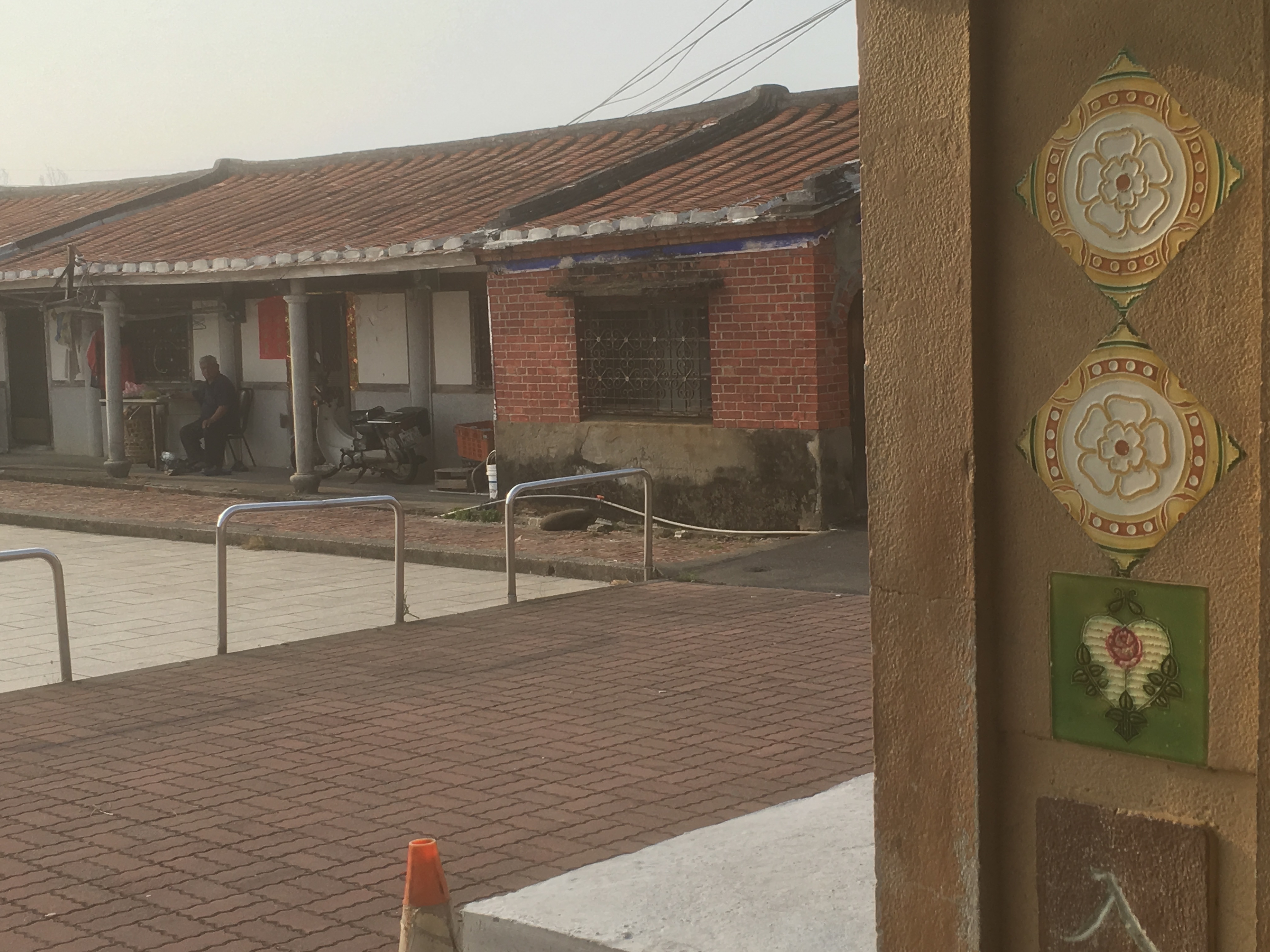

From a compound of old houses in northern Tainan county
Sometimes you can get a good deal if you buy four of a kind and frame them together.
But where does one acquire them?
Honestly, your best bet are Facebook groups. These are run almost entirely in Mandarin.
何武朝根 is an artist in Pingtung who sometimes incorporates tiles into his work. A typical piece (like the diamond-shaped ones in photos above) run approximately NT$1800, including shipping.
老花磚繽紛樂 are more expensive, but hold regular sales and have a Yahoo! Auction function. They also have the widest variety and focus exclusively on tiles. Interestingly, some of their offerings clearly came from India -- there's a Krishna on their Yahoo! Auction page.
eBay has quite a few options, including Indian and English tiles, but you'll pay a massive premium. I've never used them.
Tiles sometimes pop up in 二手。古董。老件。收藏。裝飾 but it's not all they deal with. However, seller 秦立珍 often has them and always has fair prices. She's based in Kaohsiung but ships securely.
Tiles sometimes pop up in 二手。古董。老件。收藏。裝飾 but it's not all they deal with. However, seller 秦立珍 often has them and always has fair prices. She's based in Kaohsiung but ships securely.
I sometimes post good finds that I won't buy myself in Taiwan Home Decor, but it's nothing you can't find by trawling these other pages.
老花磚Old Tiles瓷磚タイル汰嚕 doesn't sell, it's just for showing tiles one has found, but it's nice to look and see what patterns are common or rare.
I should note that all of mine are framed, but they usually don't come that way. I take them to a framer for that, and yes, it costs extra. Some of the more expensive options will occasionally come with frames, however.

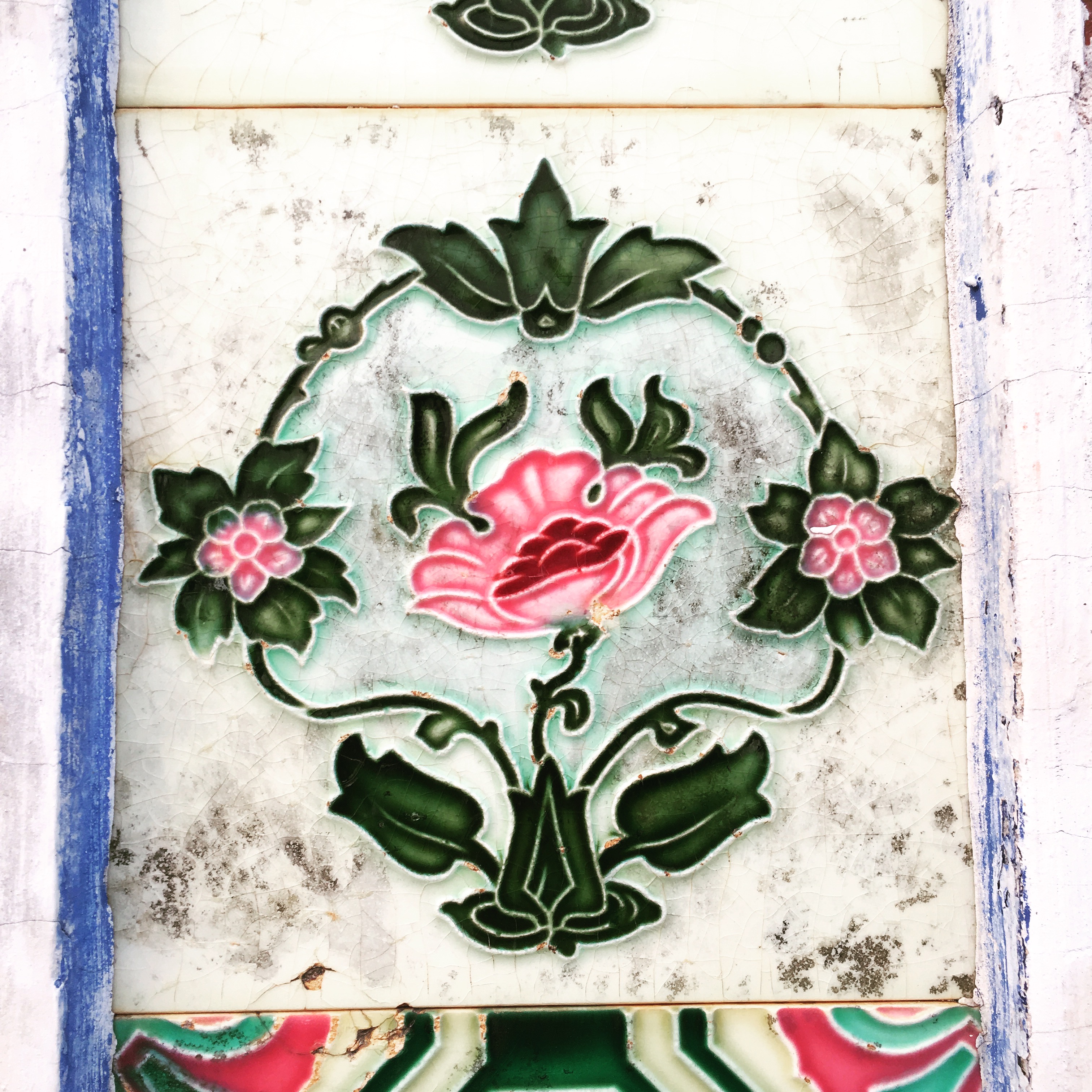
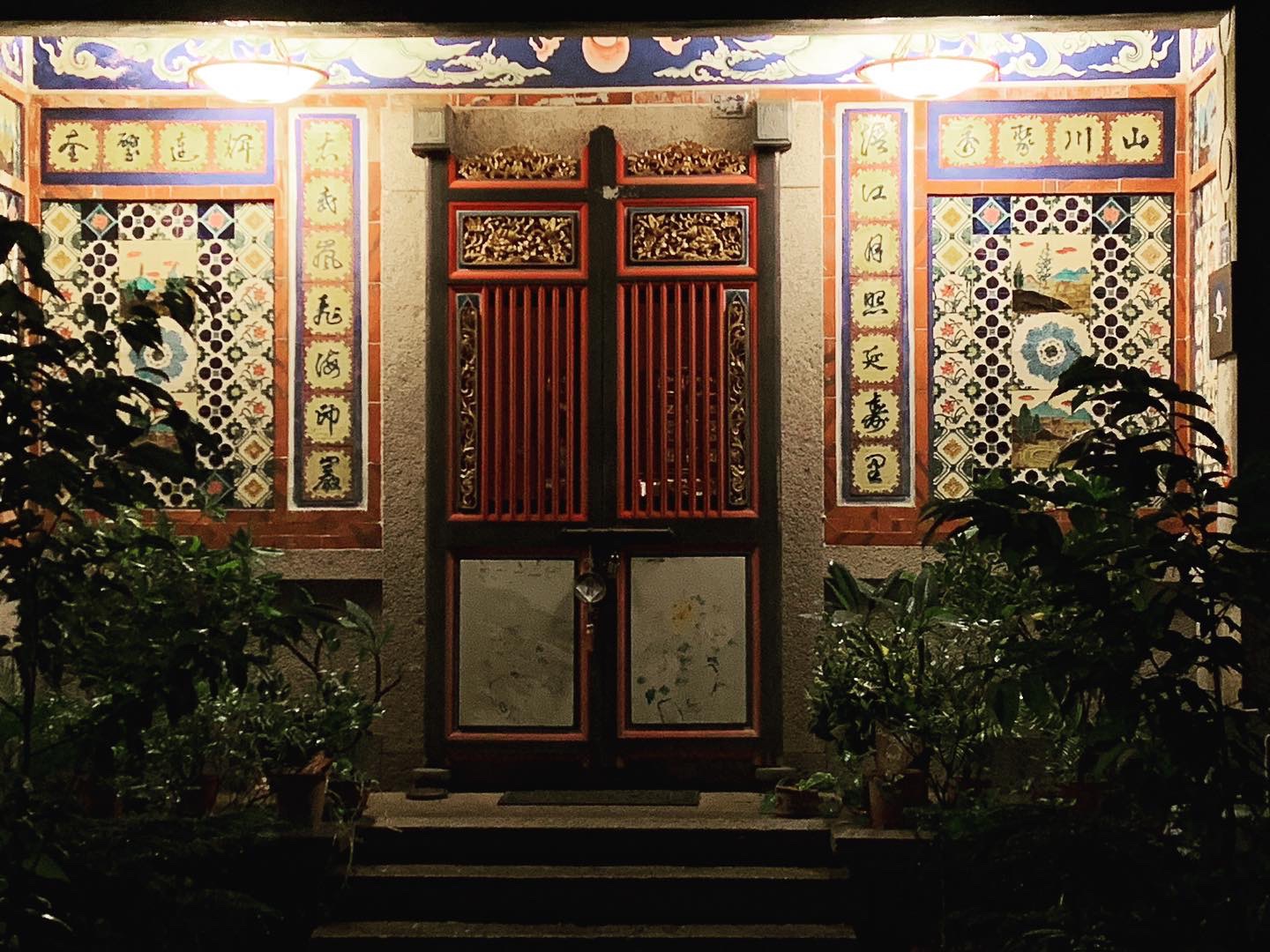


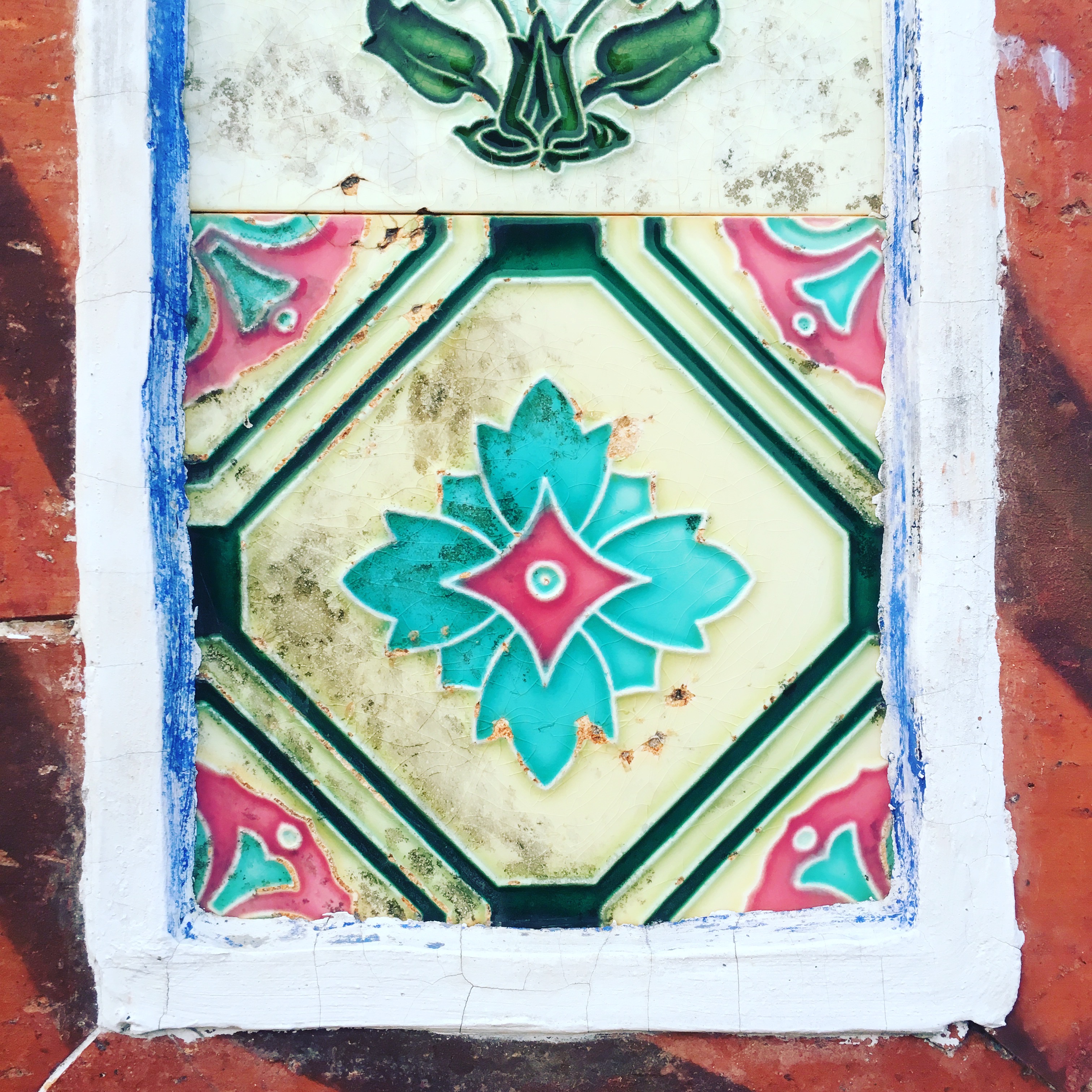


老花磚Old Tiles瓷磚タイル汰嚕 doesn't sell, it's just for showing tiles one has found, but it's nice to look and see what patterns are common or rare.
I should note that all of mine are framed, but they usually don't come that way. I take them to a framer for that, and yes, it costs extra. Some of the more expensive options will occasionally come with frames, however.

Old tiles on Kinmen and Tainan mansions -- I covet that center tile







Tiles on old houses in Tainan county
This brings us to the last question: is it ethical to buy these old tiles?
I think it is. They don't sell for enough to be worth thieves' time to go around and pry them off old houses. Every seller I've worked with has given every indication of being above board, and they're not selling patterns consistently enough that I think they're being taken unethically from someone's neglected property and put on the market. The Old Tiles group dedicated only to selling them seems to get them from a more international source, considering the inclusion of tiles obviously meant for other markets.
In fact, the one time I saw a tile -- broken, and a common pattern, but still a tile -- that had fallen naturally off of its perch on someone's half-ruined old farmhouse, the locals had perched it neatly on this brick column and left it there. The idea of taking it seemed unconscionable.
I highly doubt Majolica tile trafficking is a big deal, in other words. If I learn differently, I'll update. But you can assume you're buying from people who've salvaged them ethically or acquired them from families looking to offfload them.
I think it is. They don't sell for enough to be worth thieves' time to go around and pry them off old houses. Every seller I've worked with has given every indication of being above board, and they're not selling patterns consistently enough that I think they're being taken unethically from someone's neglected property and put on the market. The Old Tiles group dedicated only to selling them seems to get them from a more international source, considering the inclusion of tiles obviously meant for other markets.
In fact, the one time I saw a tile -- broken, and a common pattern, but still a tile -- that had fallen naturally off of its perch on someone's half-ruined old farmhouse, the locals had perched it neatly on this brick column and left it there. The idea of taking it seemed unconscionable.
I highly doubt Majolica tile trafficking is a big deal, in other words. If I learn differently, I'll update. But you can assume you're buying from people who've salvaged them ethically or acquired them from families looking to offfload them.
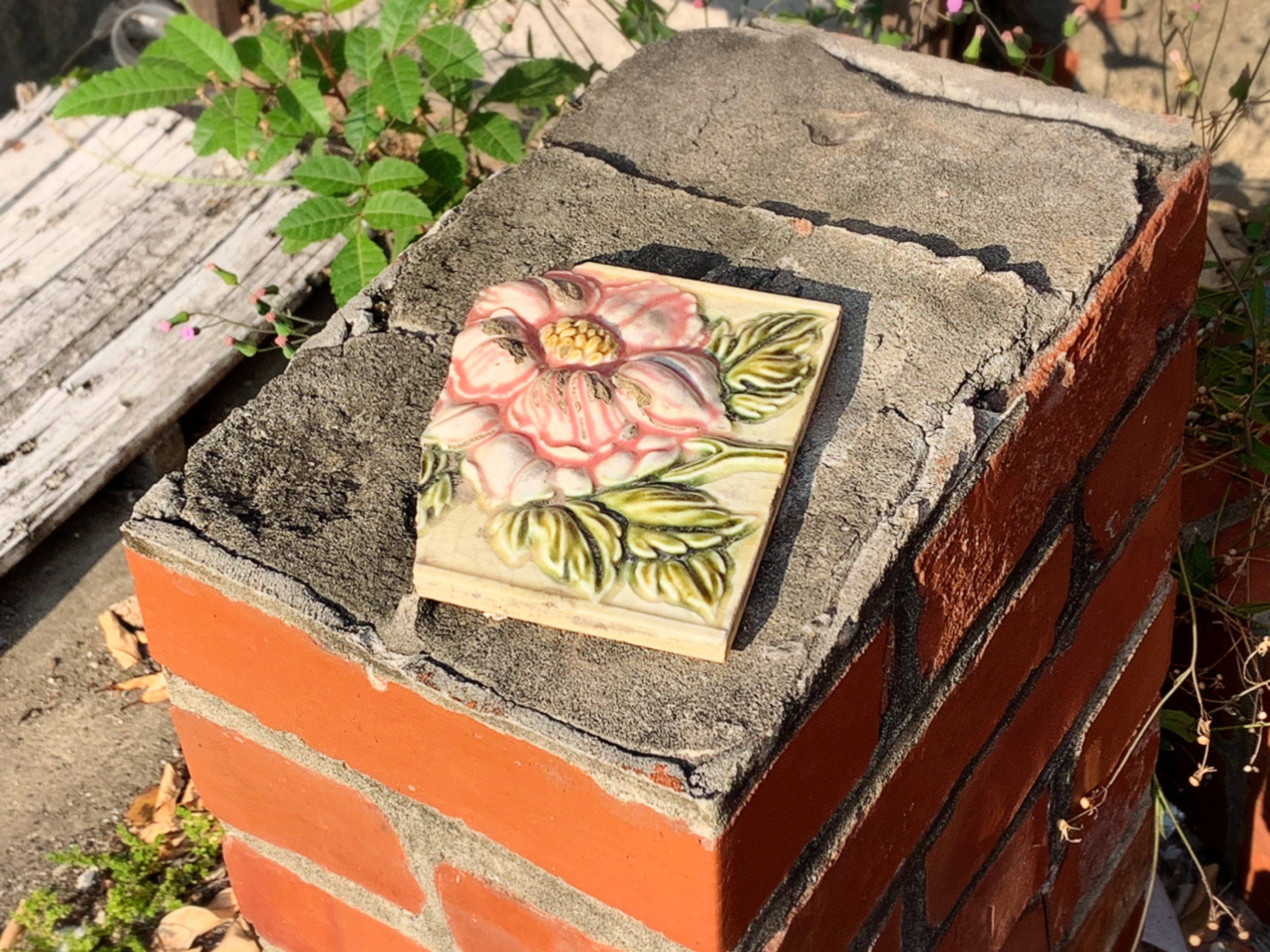
I also like collecting Taiwanese Majolica specifically because it tells a story that goes beyond the expected tropes of colonialism and the evil aspects of global capitalism. Perhaps Majolica could have been a tale of British notions of civilization and sanitation being foisted onto India and then spread across Asia. In another timeline, maybe.
It's not, though. It's a story of a ceramicware process that started in the Middle East (that is, Asia), and then became popular in Europe. When these tiles made their way toward East Asia, locals with the means decided they liked them. Rather than be willing markets for foreign producers, Japanese manufacturers figured out how to create high-quality versions more locally. Yes, Japan was an imperial power too, but nobody forced Taiwanese to buy the Majolica that began to appear. At the same time, these tiles provided an alternative to buying British during a time when India wanted to be free from Britain. The popularity of religious iconography in the Indian versions and what it says about Hindu nationalism, in a place where the original tilework methods already existed and were already associated with non-Hindu origins is indeed fascinating, but not closely related to their story in Taiwan.
Desire for these aesthetically pleasing items, produced in Asia for Asian consumers, spread via Asian -- that is, regional and local -- networks. They came to Taiwan in the early 20th century not because Japan made it so. They came because they were beautiful and affordable. Taiwan was prosperous before the Second World War, and there were middle and upper classes of locals who could afford them, and were well-traveled enough to have seen them -- perhaps in Singapore, Vietnam, Malaysia, India, Japan or even Europe itself.
That, to me, is not a colonial story from the West, though colonialism is indeed inextricable from the narrative.
Rather, it's a story of local people deciding they liked a thing merely for its beauty, having the means and worldliness to know it exists at all, and figuring out how to produce or acquire what they wanted themselves.
Now, I'd just like to see you off with some lovely pictures of Majolica tiles from around the world -- Spain, Portugal, India, and Taiwan.
Enjoy!
Enjoy!
You can also see painted tiles like this in some temples in the flat part of Beitou, but the one above in Gongguan/Taipower, near the Kishu An Literature Forest (紀州庵文學森林).
Gate of the Wu residence, relocated to Taichung Park
The Museum of Old Taiwan Tiles, Chiayi
Hoi'an, Vietnam: not sure that these are Majolica in the sense of what I collect, but the idea is more or less the same
Turkey's famous tiles and ceramics (look for the tiles at old mosques and palaces, including the Rustem Pasha Mosque and Topkapı Palace) are also technically "Majolica" in that they are fired similarly -- shiny white base, multiple colors fired together, and almost certainly originated with tin oxide pigment -- but more likely came from the Middle East rather than via Italy/Spain/Europe.
They're in the same family of decorative items, but the ones popular in early 20th century Taiwan arrived via Europe and Japan, not Turkey.
I have been to Istanbul, however, so here are some photos:
They're in the same family of decorative items, but the ones popular in early 20th century Taiwan arrived via Europe and Japan, not Turkey.
I have been to Istanbul, however, so here are some photos:

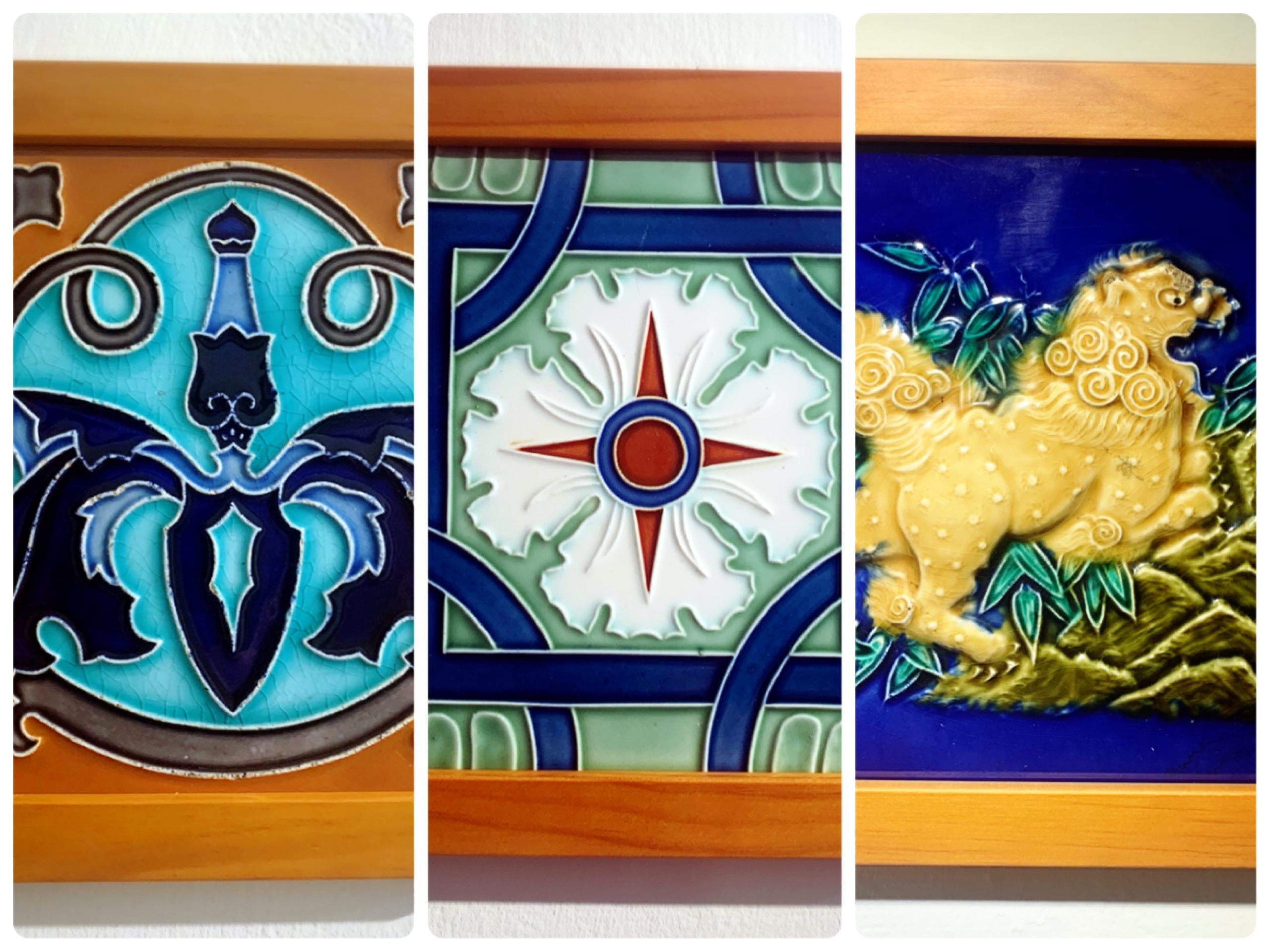

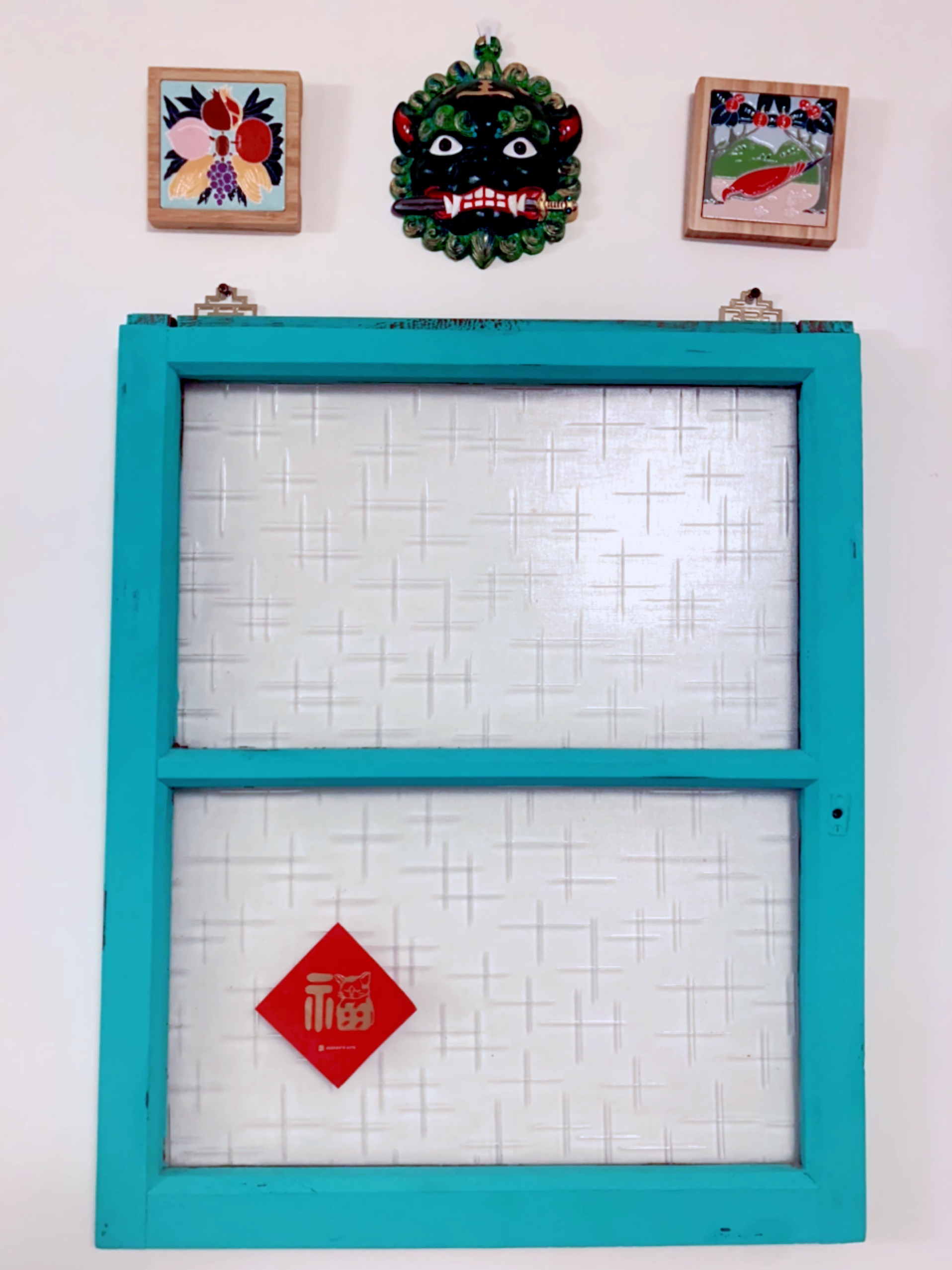

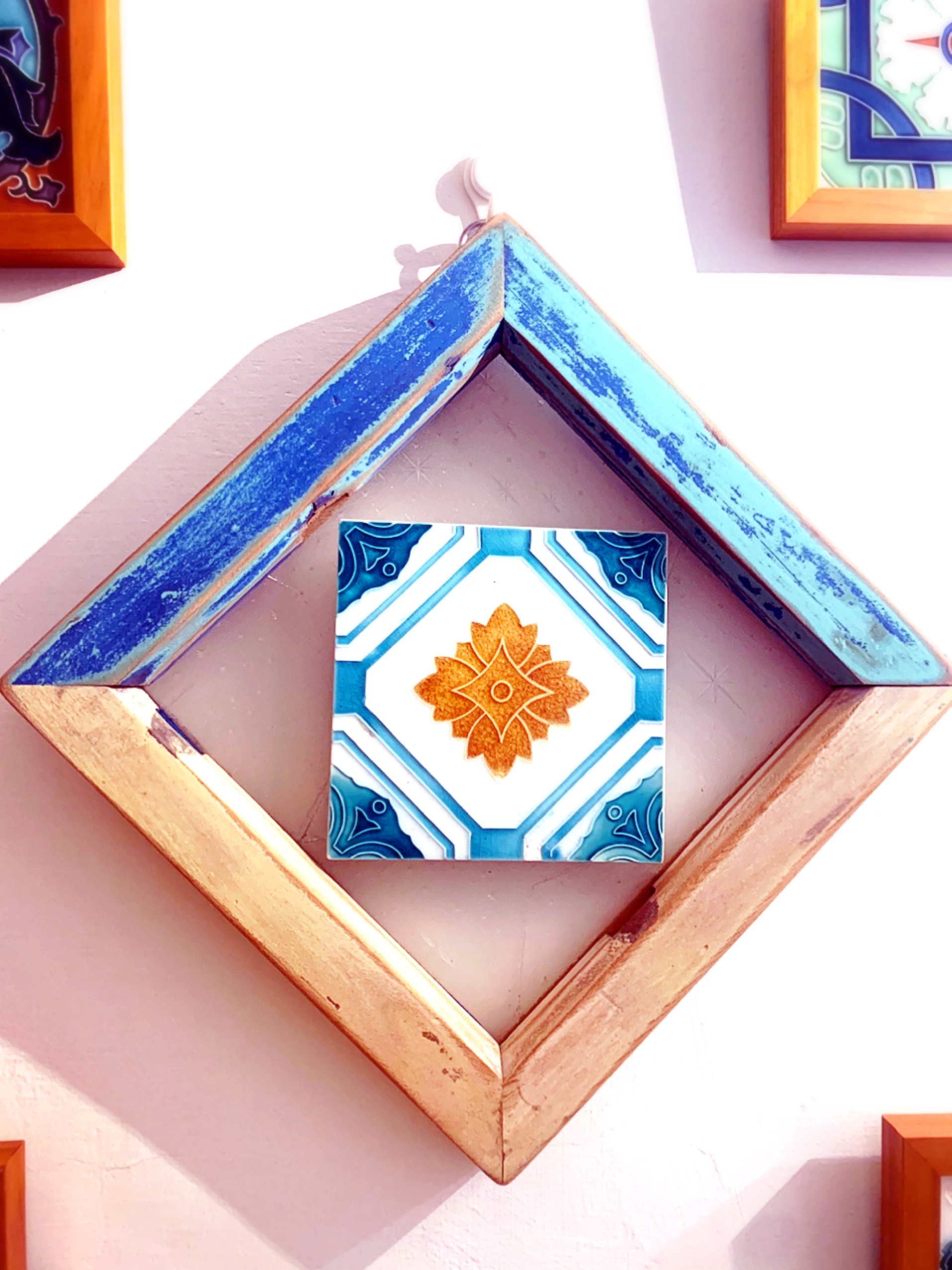

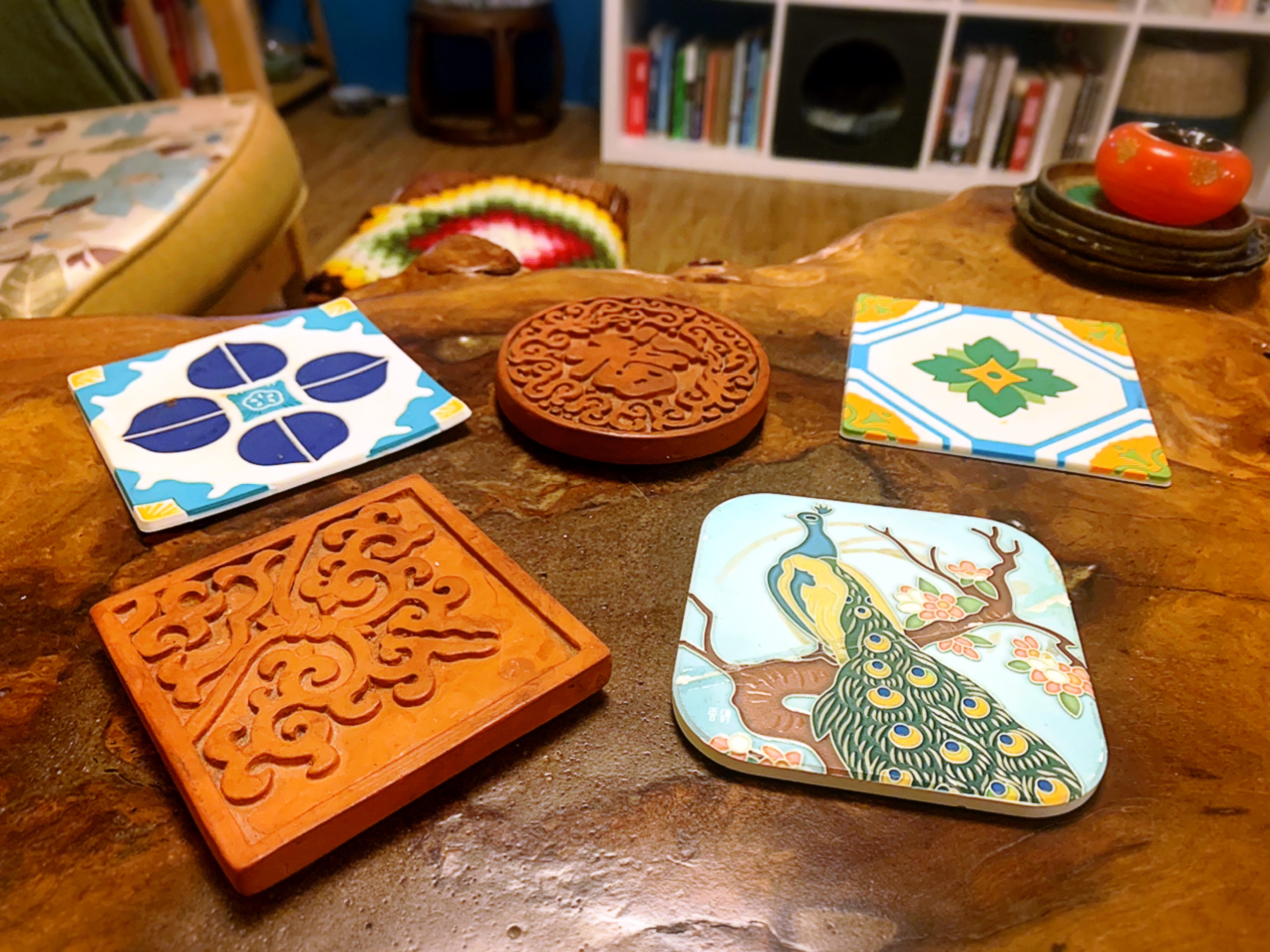
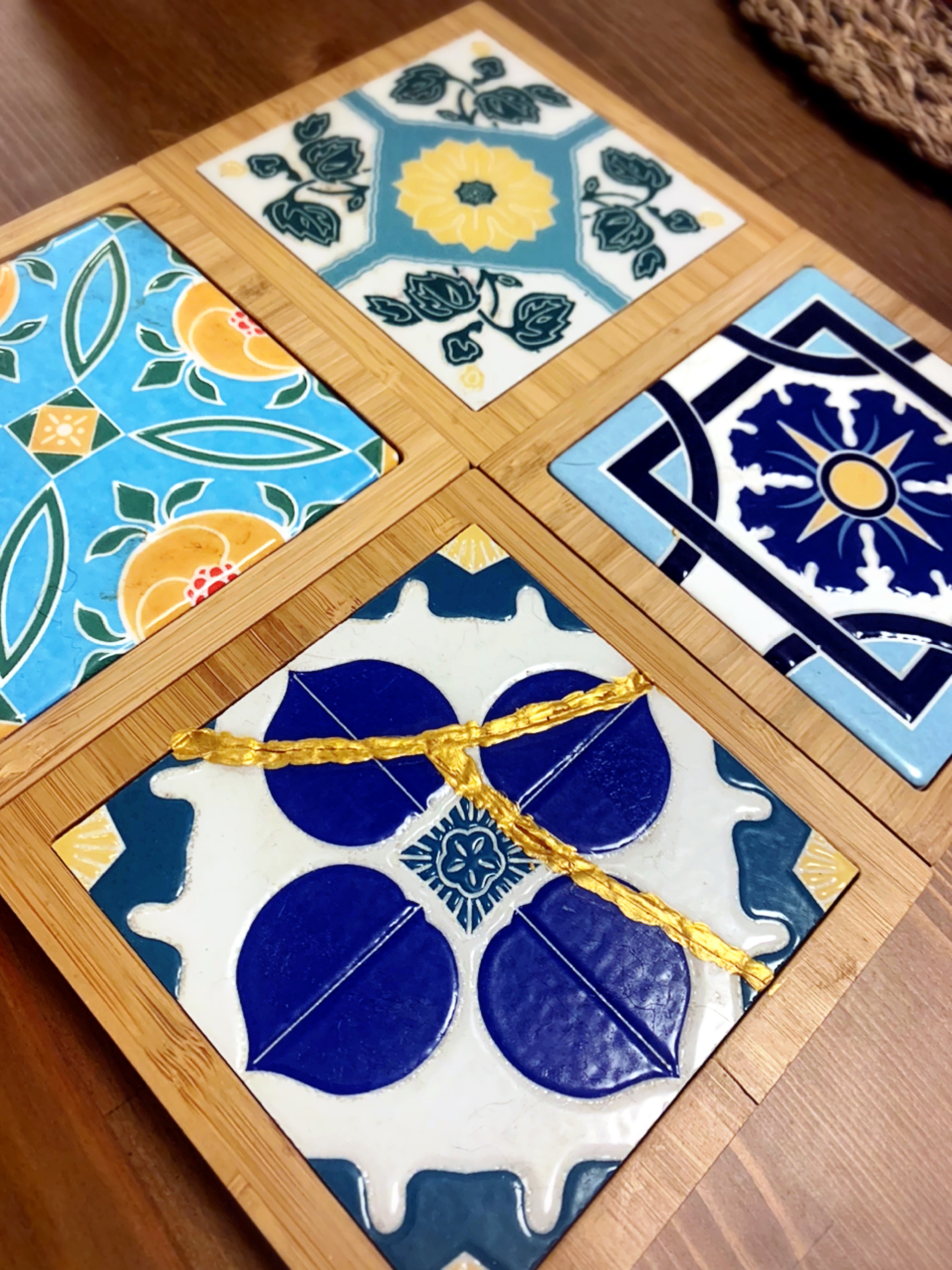
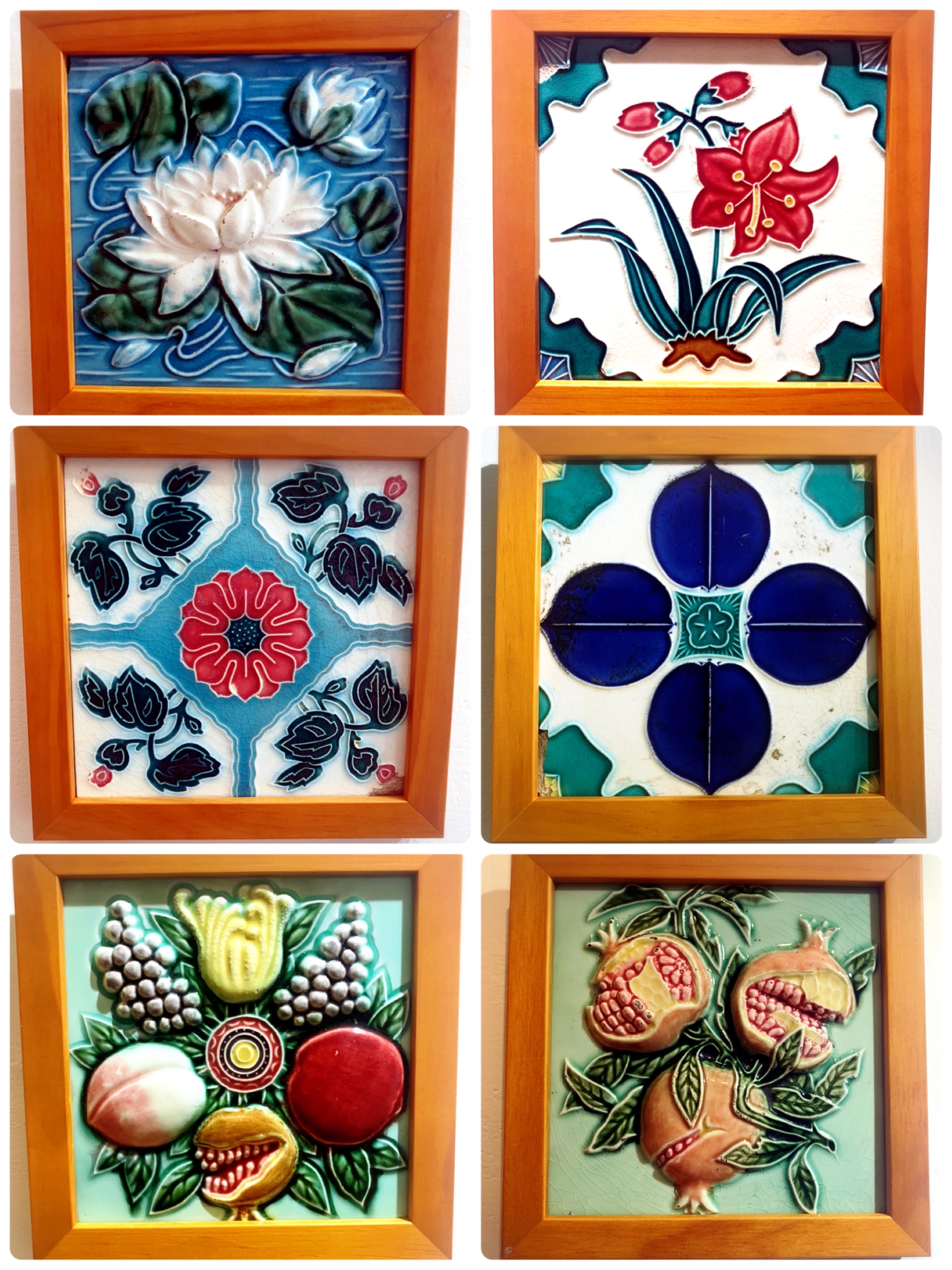



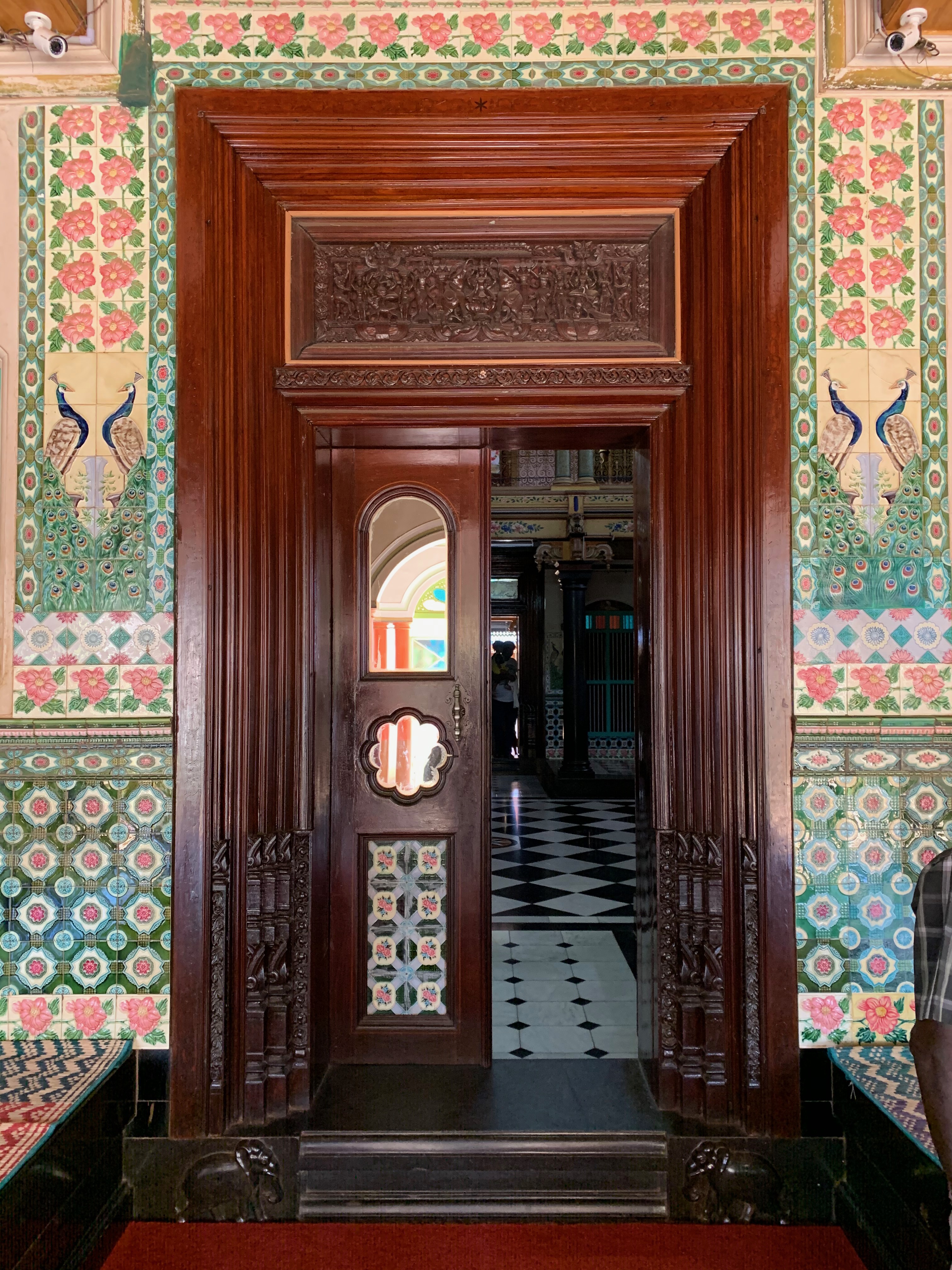

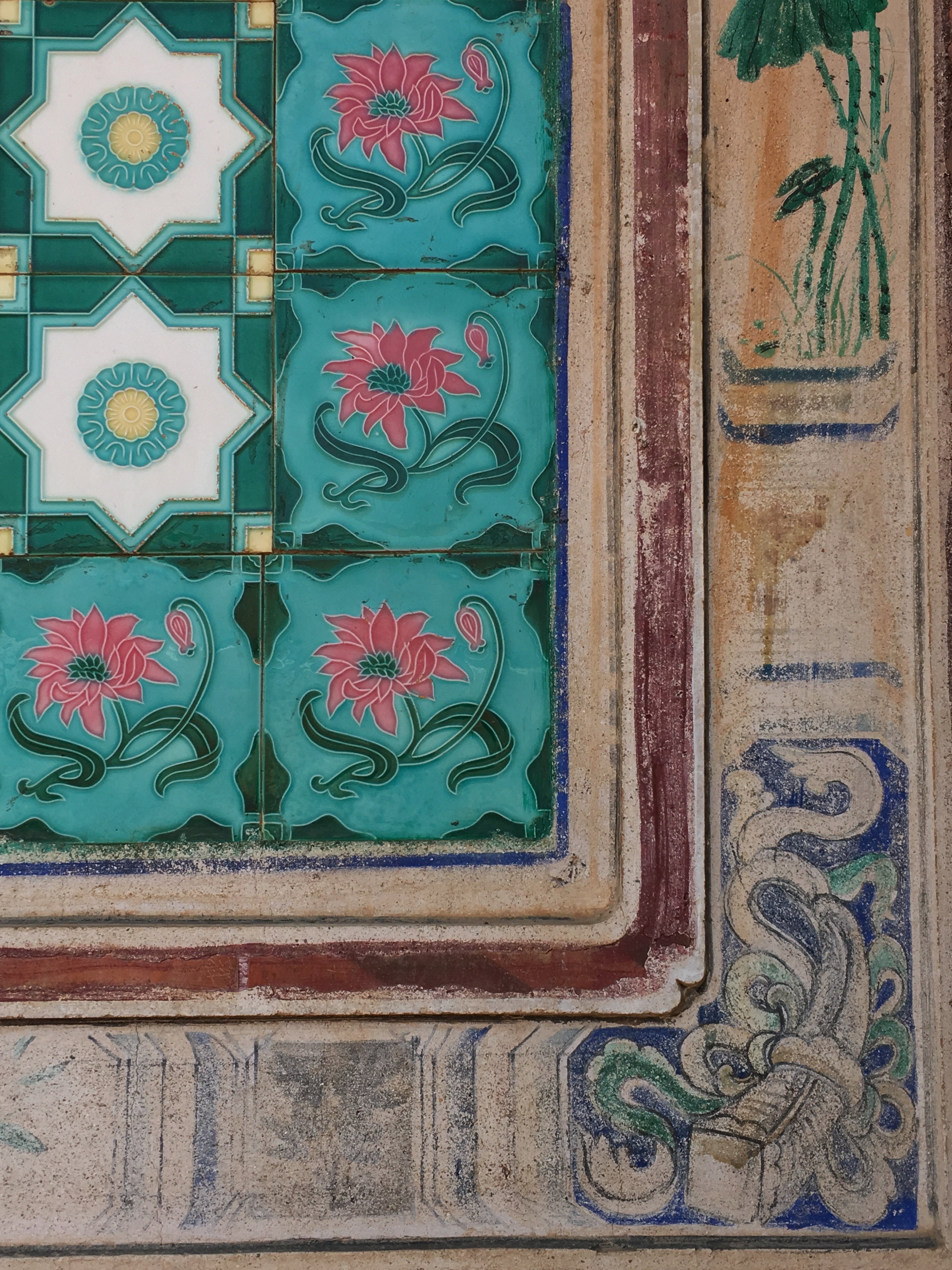
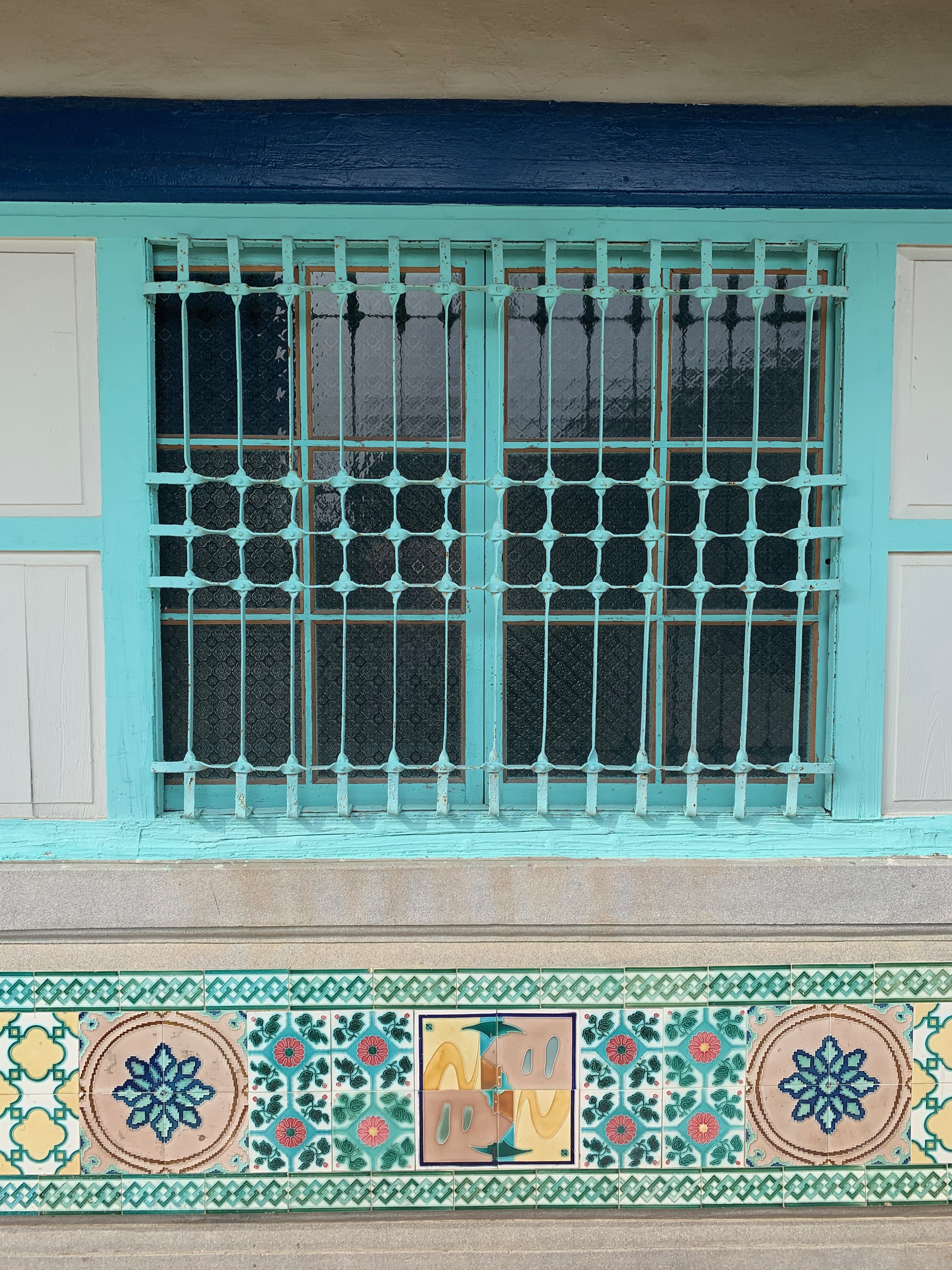
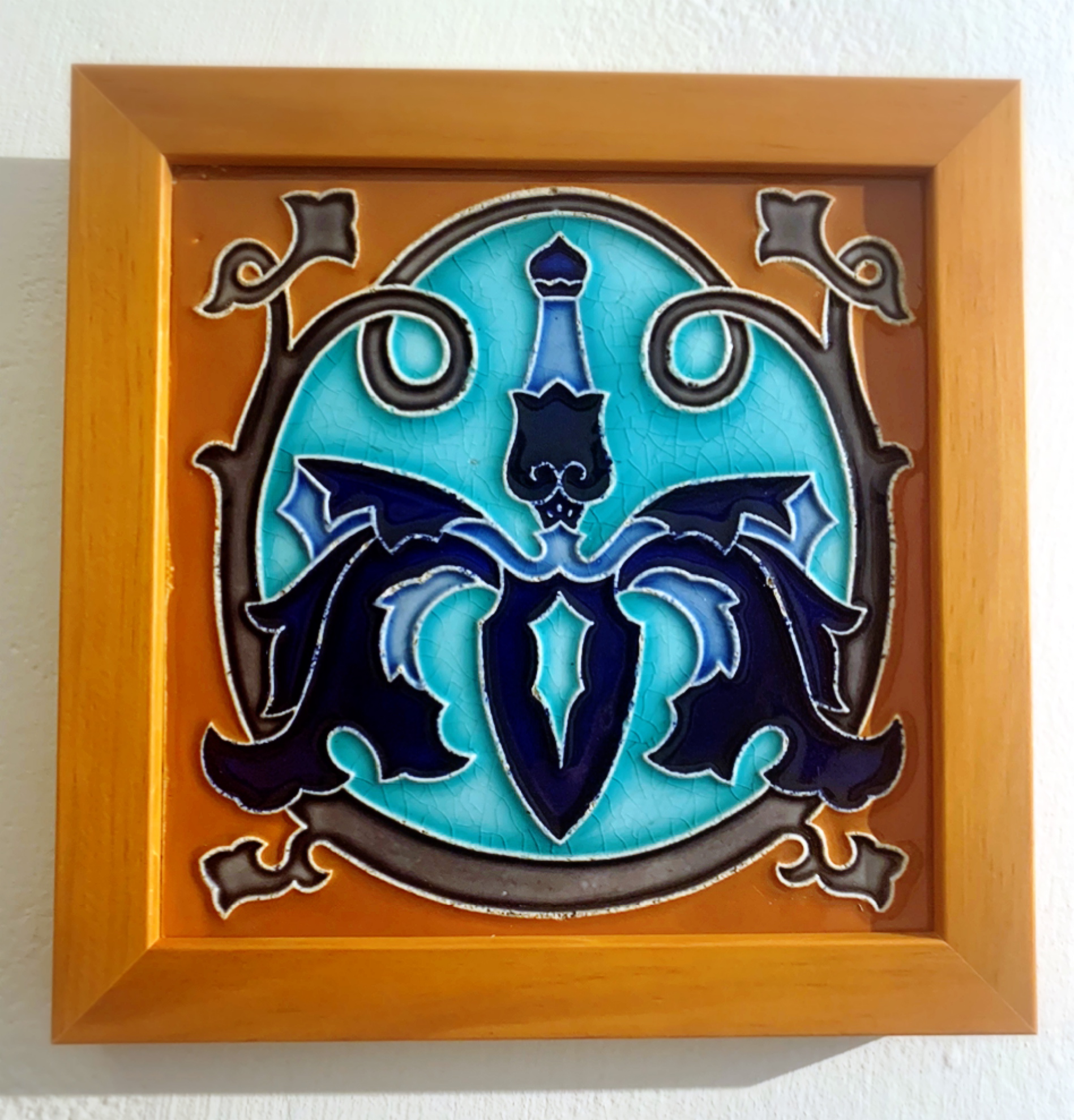

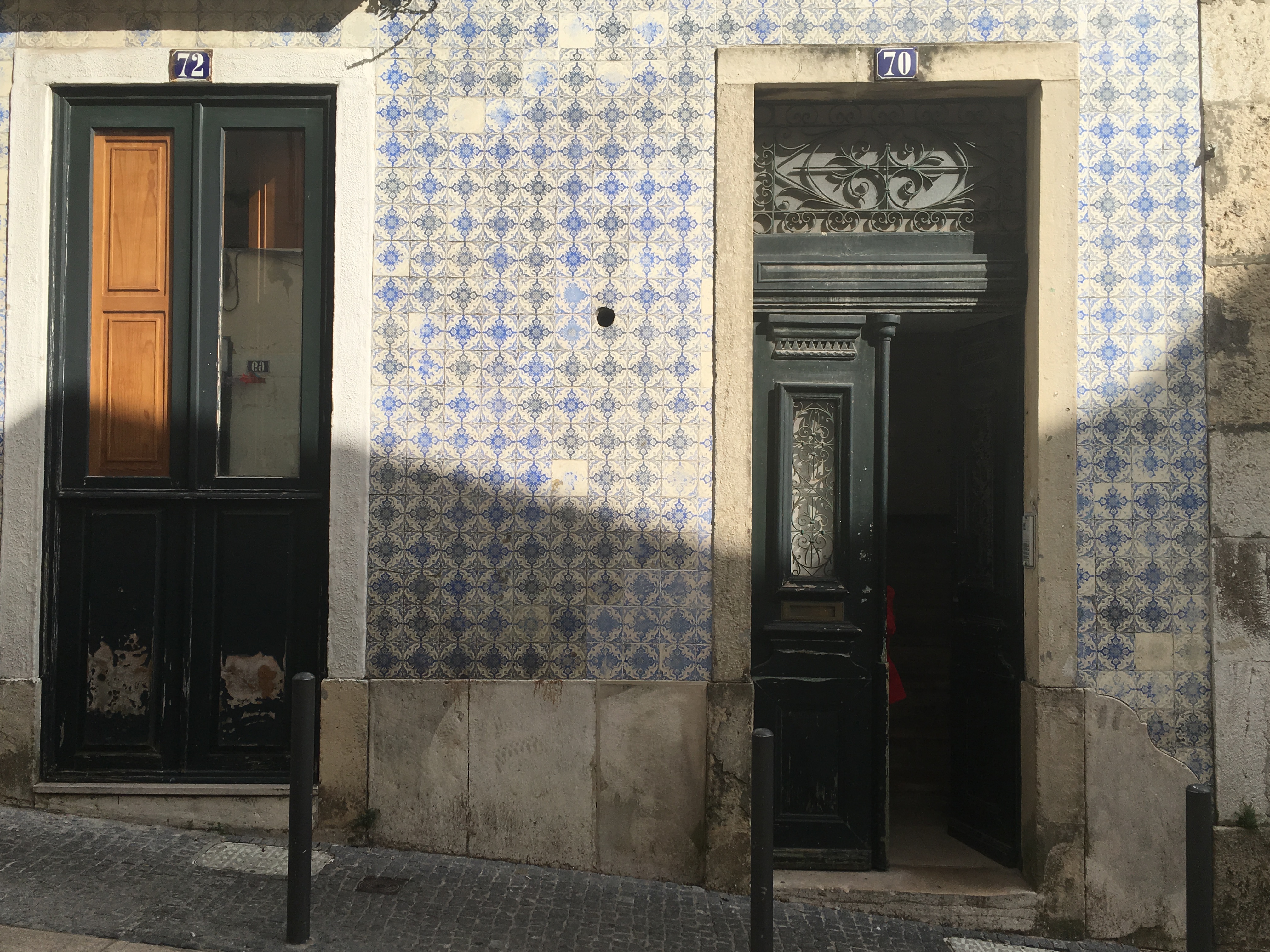






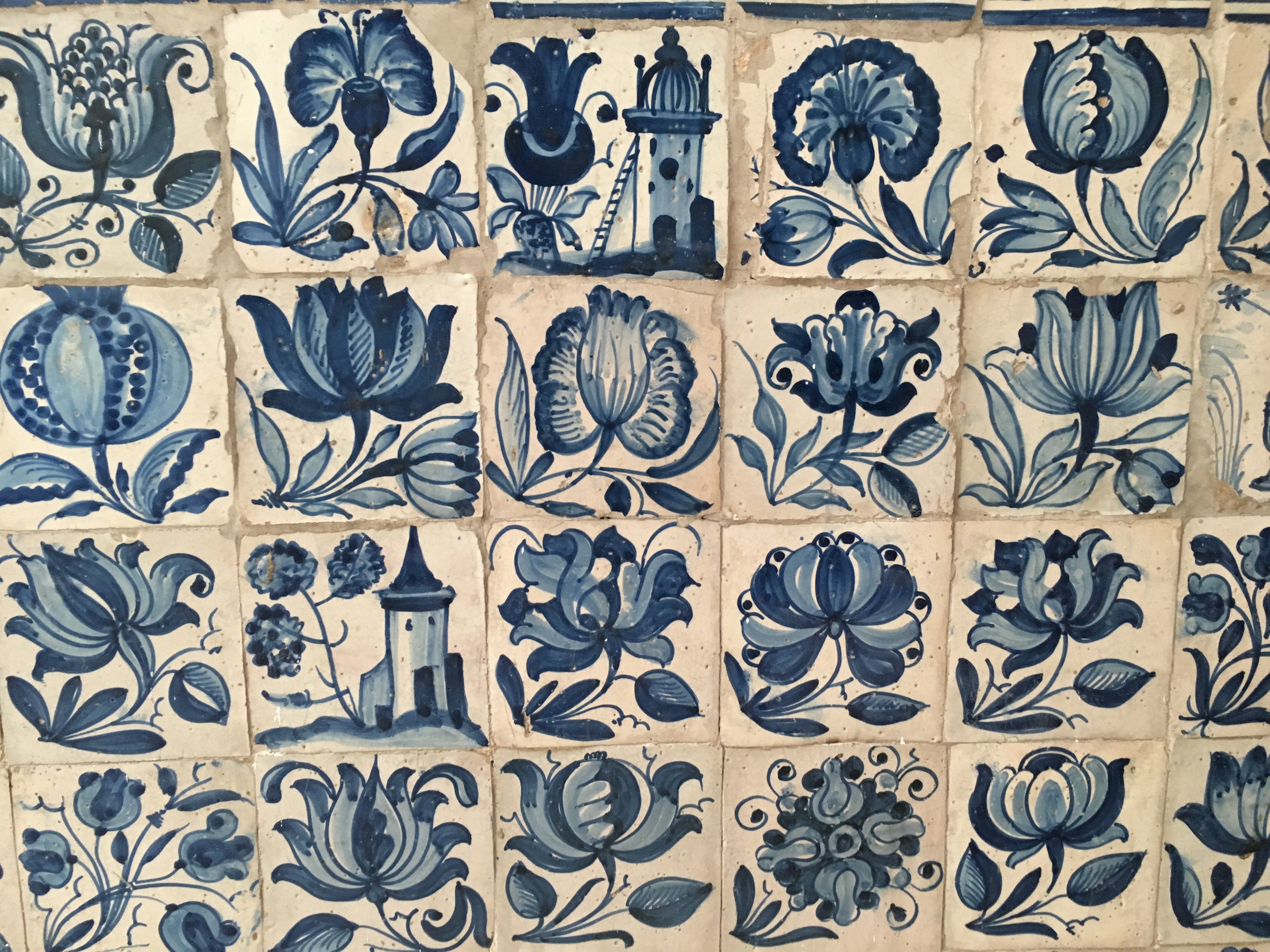
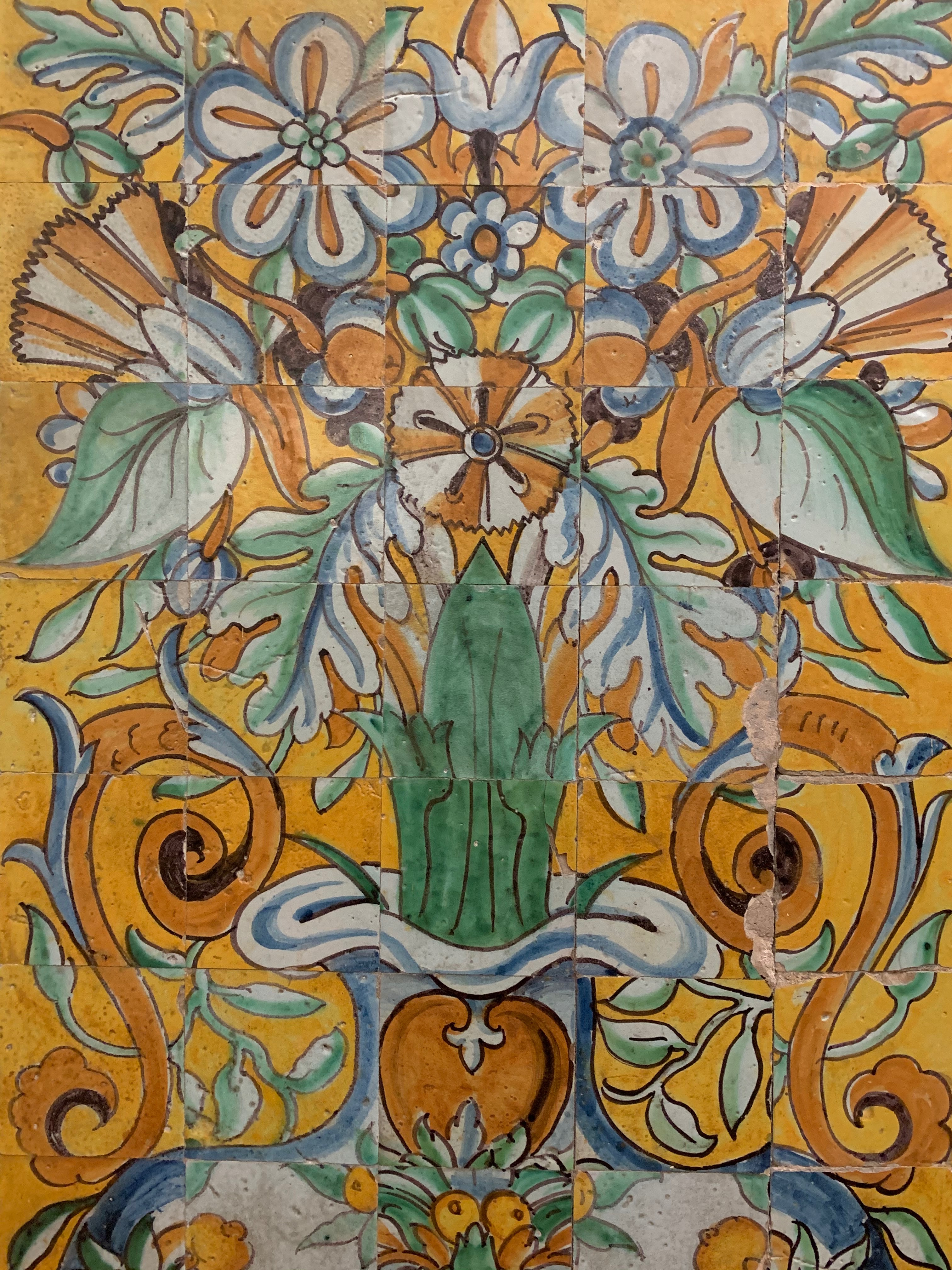
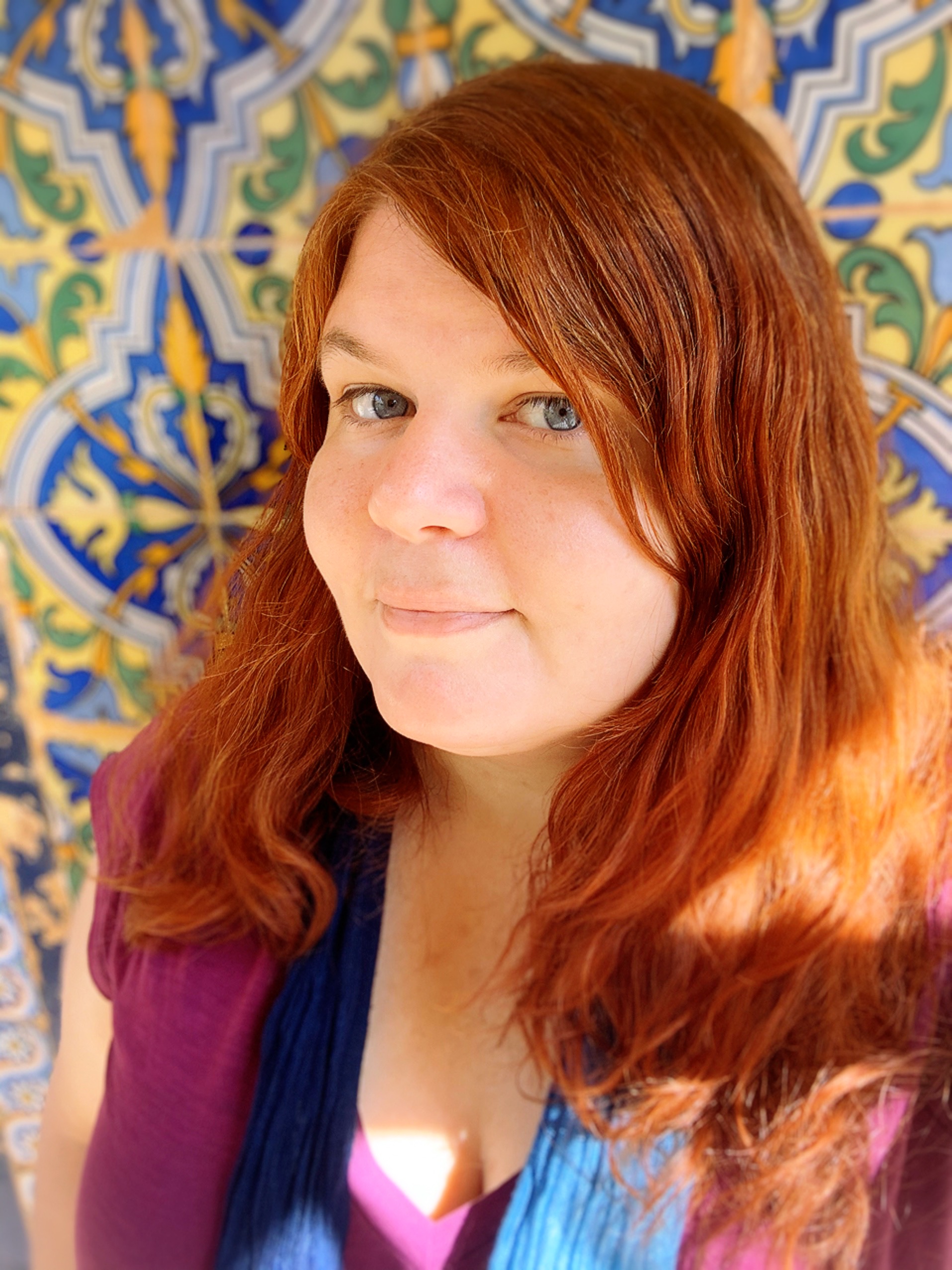




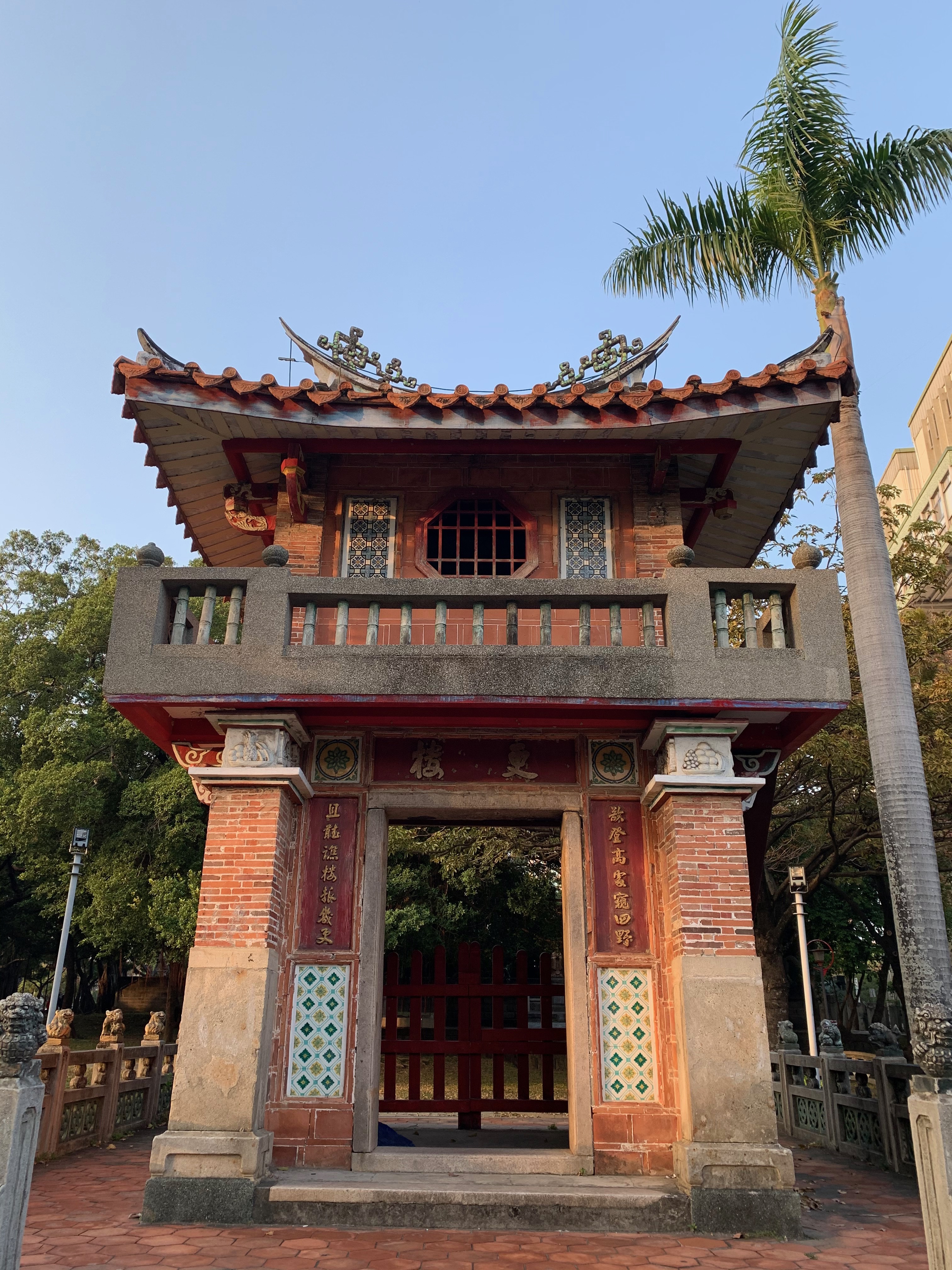









No comments:
Post a Comment